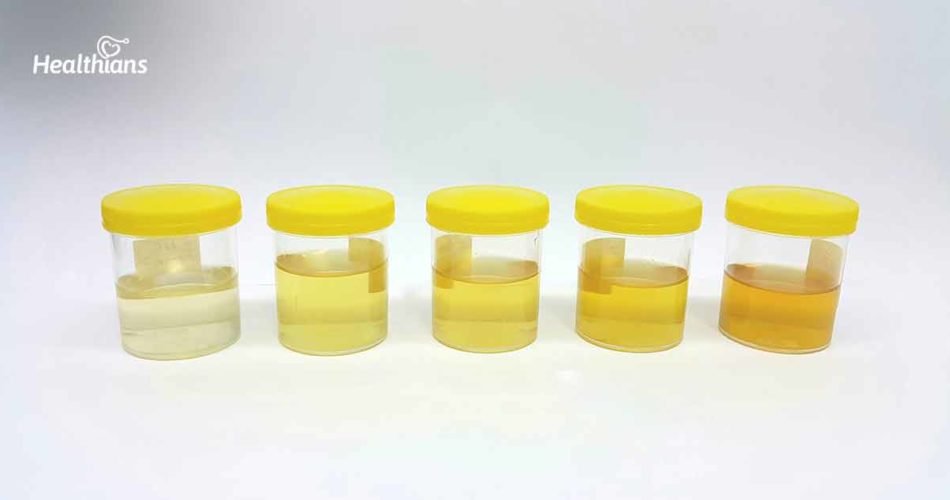Contributed by Healthians Team
Introduction
Urine excretion is the body’s natural process of removing waste. The process is carried out by the kidneys, which help purify the blood by removing waste products such as excess water, salt, potassium, and phosphorus. It also helps the body get rid of chemicals like uric acid.
Kidneys filter the blood to produce urine, which flows through the ureters (a duct that allows urine to pass from kidneys to the bladder) and gets stored in the urinary bladder.
When you are ready to urinate, pee passes through the urethra (a narrow tube that helps carry urine from the bladder) to the outside.
Changes in urine colour and odour are some of the most telltale signs of various health issues. This is why urinalysis is one of the most important parts of various preventive health checkups, as it helps in identifying several aspects that can influence the overall well-being of a person.
Thus, knowing the changes in the urine can enable you to seek early medical intervention for any prevailing conditions.
This article will inform you about a few signs related to urination that can signal possible changes in your health.
Note: The normal colour of urine is transparent yellow. Low fluid intake can cause darker urine and excessive fluid intake can lead to more diluted urine.
Colourless or transparent urine
Passing colourless or transparent urine is common if a person drinks more than the recommended amount of water, which is approximately two to three litres of water every day.
Studies suggest that consistent overhydration can disturb electrolyte levels and the levels of sodium in the blood. It can also give rise to symptoms like muscle weakness, spasm, cramps, or seizures.
If a person drinks the appropriate amount of water and still experiences colourless urine, it can be a sign of underlying kidney complications or diabetes thus making it important to consult the doctor at the earliest.
Pale to dark yellow-coloured urine
The healthy colour of urine falls between pale yellow to a dark yellow colour. The urine gets its yellow colour from a pigment called urochrome which is produced as a by-product of haemoglobin breakdown and is filtered by the kidneys.
Depending on the level of fluids in the body, the colour of urine can be between pale yellow to dark yellow.
Brown to dark amber-coloured urine
When the levels of fluid are less than what the body requires, the waste products in the urine cannot be diluted, which leads to more concentrated urine, thus leading to changes in the colour of urine.
Thus, if you see the urine colour getting darker, it can be due to dehydration. Drink a little extra water for the next few hours to manage the condition.
Dehydration not only occurs due to lack of fluid intake but can also arise as a result of conditions such as fever or diarrhoea, and if a person has been sweating due to increased exposure to heat or physical exertion.
If the dark colour of urine does not change to light colour even after drinking sufficient water, it may be due to an unhealthy liver.
Despite waiting for the colour to change on its own, it’s better to consult a doctor to prevent the worsening of the condition (if any).
Reddish or pink-coloured urine
This might sound a little unexpected, yet the urine can come out in pink or reddish colour.
According to experts, this mostly happens when a person consumes foods like beetroots, blueberries, and rhubarbs or is on certain medications.
If there have been no changes in the diet or medications that can give rise to this condition, consider seeking medical intervention as soon as possible, as the red or pink colour could be due to:
- Blood in the urine
- Kidney diseases
- Prostate issues
- Kidney stones
- Urinary tract infection (UTI)
- Cancer (in rare cases)
- Lead or mercury poisoning
Orange-coloured urine
Mainly dehydration is the reason behind the orange colour of urine. But if it is accompanied by light coloured stool, then there may be a condition related to the liver or bile duct.
Do not panic! Take measures to rehydrate and if the urine colour is still orange, consult your doctor and take steps to prevent any serious complications.
Blue or green-coloured urine
Blue or green coloured urine sounds uncommon, right? But it is possible if a person eats food loaded with artificial colours or has undergone any kidney or bladder function test.
In rare cases, hypercalcemia (a genetic disease) and urinary tract infection (UTI) can also cause the urine colour to be green or blue.
Consult a physician if you see such changes in the colour of your urine.
Cloudy urine
Cloudy urine is another symptom of dehydration. If rehydrating does not solve the problem, consult a medical practitioner at the earliest as it can be a symptom of conditions like:
- Unmanaged diabetes
- Urinary tract infection (UTI)
- Kidney stones
- Kidney diseases
Foaming urine
Seeing a little foam on the surface of the water in a toilet bowl is normal when you’re peeing.
However, concentrated urine can also cause foaming which might be indicative of an excess of a protein type, called albumin.
This can be related to the onset of kidney ailments and requires immediate medical attention. Here are a few symptoms of kidney complications that can cause foaming urine.
- Nausea
- Muscle cramps
- Frequent urination
- Swelling in the hands, feet, belly, or face
- Damaged kidneys
- Appetite loss
Bright or neon yellow-coloured urine
Increased intake of vitamin supplements can make the urine appear bright or neon yellow. It’s harmless and more common if there is a high intake of vitamin B supplements.
Foul or unusual odour
If a person consumes too much asparagus, garlic, and onions, or drinks coffee, an unusual odour of the urine is normal.
However, the foul smell can also arise due to certain conditions such as:
- Urinary tract infection (UTI)
- Burning sensation or pain while urinating
- A sweet smell of urine can be a sign of diabetes
- Liver complications
If you experience a foul smell while urinating and doubt that it may be due to health-related issues and not what you ate, consult your doctor immediately to minimize the chances of serious complications.
Final thoughts
Knowing the above-mentioned 10 changes that you can experience while passing urine can help you keep an eye out on the onset of an illness or check for signs of an underlying one.
Knowledge empowers and thus with this article you are now empowered to check for telltale signs of urine abnormalities and take preventive steps to minimize the impact
To determine the exact cause of the change in the urine’s odour or colour, it’s best, it’s best to take a periodic kidney function test.
It can give a good insight into your health, allowing you to take measures to improve your well-being.




